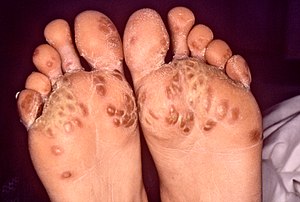Keratoderma blennorrhagicum
| Keratoderma blennorrhagicum | |
|---|---|
 | |
| The rash on the bottom of this individual’s feet, known as keratoderma blennorrhagicum, was due to reactive arthritis | |
| Specialty | Dermatology |
Keratoderma blennorrhagicum etymologically meaning keratinized (kerato-) skin (derma-) mucousy (blenno-) discharge (-rrhagia) (also called keratoderma blennorrhagica)[1] are skin lesions commonly found on the palms and soles but which may spread to the scrotum, scalp and trunk. The lesions may resemble psoriasis.[2]: 195
Keratoderma blennorrhagicum is commonly seen as an additional feature of reactive arthritis in almost 15% of male patients. The appearance is usually of a vesico-pustular waxy lesion with a yellow brown colour. These lesions may join together to form larger crusty plaques with desquamating edges.
See also[]
- Keratoderma
- Keratosis
- Blennorrhea
- List of cutaneous conditions
References[]
External links[]
| Classification |
|---|
Categories:
- Psoriasis
- Cutaneous condition stubs